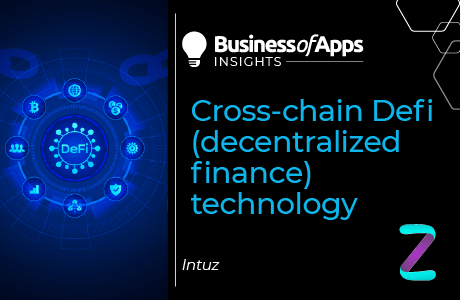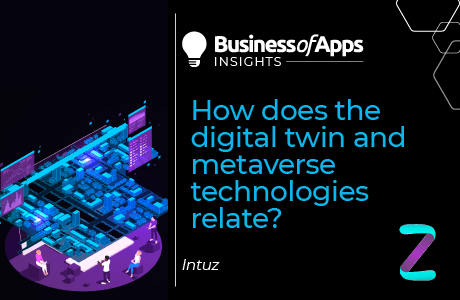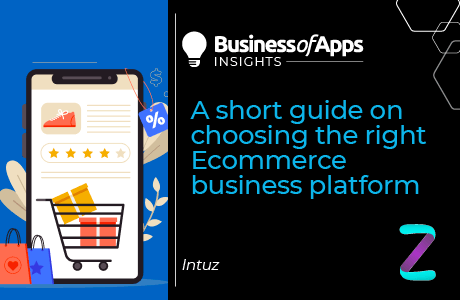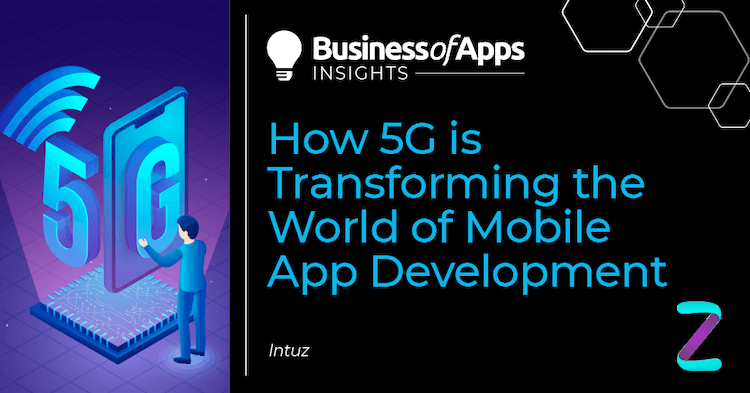
Technology is rapidly evolving alongside consumer preferences, and for a good reason. The need for improved connectivity, easier accessibility, and higher speed has driven the constant technological advancements.
Developers are consistently trying to meet consumer needs as the number of smart device users and the latest technology adopters increase exponentially.
As per Statista, there were approximately 3.5 billion mobile phone users worldwide in 2020, and this number is set to increase in 2021 to 3.8 billion. The reason is deeper internet penetration in large population countries like India and China and emerging economies in the Africa subcontinent.
The rise and rise of 5G
The Fifth-Generation wireless cellular network (5G) is the latest radio technology built to deliver high-speed performance. It is not an upgraded version of 4G, but a different technology altogether — one that is worth mentioning in this day and age.
Experts predict it will do much more than significantly improve the network connection. Due to 5G’s unified connectivity fabric, connecting devices to gather and share information in real-time will become more comfortable and helpful.
From reducing road accidents to predicting production lines, multiple domains can benefit from lag-free connectivity. No wonder 5G has received a tremendous response since its much-awaited launch in April 2019.
Although an extensive rollout has been delayed due to COVID-19, the world has its eyes on 5G. Mobile operators are expanding and upgrading their networks by investing $160 billion each year in the deployment of 5G.
5G for mobile apps: the changing landscape
So as we see, 5G is ready to transform the mobile device industry. It is also prepared to have a massive impact on mobile applications too. The 5G technology is set to take the user experience up by several notches through its enhanced features offered at a better speed.
5G-powered mobile apps will allow users access to progressive technologies such as IoT, UltraHD videos, cloud computing, Augmented and Virtual Reality (AR & VR). All set and done: 5G will hugely transform mobile app development.
Let us explore 5G in detail in this mobile app development guide:
Four features of 5G that will influence mobile app development
5G is laying the foundation of the future of communications through its all-new network architecture. The technology is set to disrupt industries by offering seamless connected experiences better than the fixed broadband.
No wonder mobile app developers have to pull up their socks to accommodate this high-end technology. If you are wondering how to get started — fret not. We listed the main features of 5G that affect mobile app development.
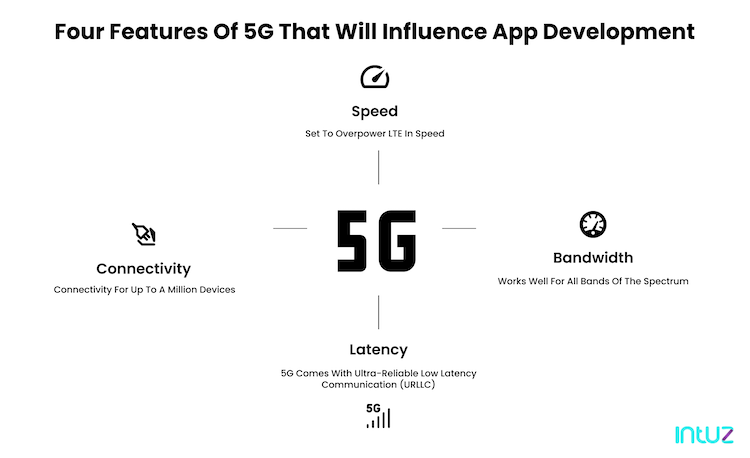
Speed
5G is set to overpower LTE in speed as it is around 100 times faster than 4G. Currently, LTE is the most rapid mobile technology. It transfers a maximum of 300 megabits of data per second (Mbps) — and that is a huge number.
Research shows 5G can deliver up to a maximum of 3 Gigabits of data per second (Gbps). This speed is expected to increase 20 folds to a speed of 10 Gbps in the future. This will enable users to transfer and download files in a flash, saving time and improving app usability.
Latency
5G comes with Ultra-Reliable Low Latency Communication (URLLC), enabling it to deliver data in just a millisecond. Minimal network interference will allow mobile apps to deliver data in real-time. 5G offers a substantial reduction in latency than the average latency of 50 milliseconds experienced over 4G networks.
Connectivity
5G will offer connectivity for up to a million devices. Increased connection density will enable smoother implementation of IoT in mobile apps.
The feature overcomes the limitation of 4G to connect only 2,000 devices at a time within 0.38 square miles. It has enhanced capabilities to handle colossal network traffic while allowing seamless communication between apps and hardware.
Bandwidth
5G is designed to perform across a wide array of bands to offer better connectivity. The mobile applications will work well for all bands of the spectrum, including – Low band (below 1 GHz)- used by LTE, Mid band (1 GHz to 6 GHz), and High band involving millimeter waves (mmWave).
But how will this telecommunications technology influence the agile app development process? We are glad you asked. This brings us to the next section:
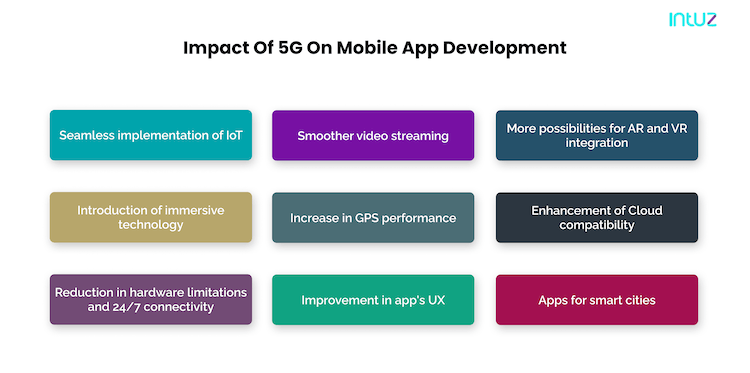
Impact of 5G on mobile app development
Seamless implementation of IoT
5G will enable the broader application of IoT through app development for different types of connected devices. The applications will support seamless connectivity across smart gadgets, wearable devices, and sensor-based equipment.
They will possess the capabilities to perform optimally using narrow bandwidth and less power consumption. Developers can also leverage AI and ML and combine them with the power of 5G to incorporate ambient computing into their apps to make them smarter.
It will drive a smarter and seamless user experience as the adoption of connected devices gains momentum. In a nutshell, companies have the opportunity to drive high revenues with robust technology such as 5G on mobile apps.
Smoother video streaming
5G-powered applications are predicted to deliver media-rich user experiences. The technology will revolutionize video streaming by supporting high-resolution live streaming at a faster speed.
Reduced latency will help smoothen the performance of video apps. Prolonged battery life will ensure an uninterrupted viewing experience.
Developers can take the opportunity to include high-performing 4K videos in the app to highlight products and services. It is a win-win for users as well!
More possibilities for AR and VR integration
Developers have not been able to incorporate AR and VR into their mobile applications on a large scale due to network issues. 5G promises to deliver the data transfer speed and efficiency to build an augmented user experience.
These apps will perform effortlessly as 5G empowers them to overcome latency and bandwidth concerns. They will deliver more interactive and engaging experiences by processing higher volumes of data at much faster speeds.
From eCommerce and retail to automobile and sportswear — AR and VR technologies can predominantly change the way consumers shop by allowing them to make changes and create a product that is in perfect sync with their tastes and needs — all from their hand-held devices.
Introduction of immersive technology
5G can boost 3D and immersive AR-based mobile app development. These apps will become a game-changer in the mobile app development industry. They will be useful in offering 3D features across verticals ranging from immersive gaming to 3D printing.
These future-proof applications will be useful in a wide variety of industries, from construction to healthcare. For instance, IKEA already deploys the technology through the “IKEA Place” app that provides a catalog of over 2,000 products for customers to test in a room with simple touches. It cannot get better than this!
Increase in GPS performance
GPS-based mobile app development will see an improvement in the precision of information delivery. The speed improvements and better connectivity offered by 5G will ensure accuracy of results in real-time, strengthening the performance of navigation applications.
These apps will be useful for the automotive industry. They will improve the efficiency of autonomous vehicles. They can also help deliver better-connected experiences through wearable gadgets and portable devices.
Enhancement of Cloud compatibility
Scalability is a critical characteristic supported by 5G technology. The extremely high transmission rates will allow quicker and easier transfer of files to the cloud. This will encourage the shifting of technical infrastructure and storage to the cloud.
Developers will incorporate cloud accessibility in their mobile app development to reduce dependence on device hardware. Low latency and high performance will allow users seamless access to their cloud storage.
Reduction in hardware limitations and 24/7 connectivity
5G-enabled mobile apps will be unaffected by hardware limitations. The technology empowers developers to integrate technologies that drive personalized interactions backed by real-time connectivity and cloud-based services.
Since 5G is a more reliable and battery-efficient network than its predecessors, devices are less likely to disconnect from the network. With such always-on connectivity, companies can leverage the constant access for their mobile apps, providing users with a more advanced ambient connectivity.
Improvement in app’s UX
The improved connectivity offered by 5G will decrease an app’s load time, making it more responsive. This will significantly improve user experience by lending higher visual clarity to the app and enhancing its performance. Developers will be able to pack in more functionalities into the mobile app while boosting UX.
Apps for smart cities
5G adoption is not going to be limited to only IoT space. In fact, it will enable the creation of “smart cities” that would be equipped with billions of sensors and interconnected devices.
On the other hand, smart cities will offer a unique platform for business development where multiple mobile apps will be synchronized to prevent crime, reduce pollution, and create real-time disaster alerts, among others.
This will give rise to a new type of collaboration opportunities for both non-competing and competing businesses.
Summing it up
The pandemic has stretched the timelines by which 5G was predicted to be rolled out globally. However, its wider adoption over the years will allow developers to bring out the best in the technology and fully tap into its potential.
5G will transform the mobile app development process to support apps that perform beyond 5G-enabled smartphones. Evolving user demands will make it imperative for developers to leverage the advantages of 5G in their mobile applications.
They will be able to develop apps that perform equally well with wearable gadgets and IoT devices. But for now, companies will implement 5G technology as a supplement to other existing networks.
This will result in lower energy costs and longer battery life as the increased internet speed will perform almost all calculations on the server-side. To wrap it up — enriching user experiences will lead to increased user retention rates and higher app revenues in the future.
Did you enjoy reading the insights on how 5G can transform the app development segment thoroughly? Excited to have a deeper knowledge of the steps involved in app development? Read this detailed guide for more information.





